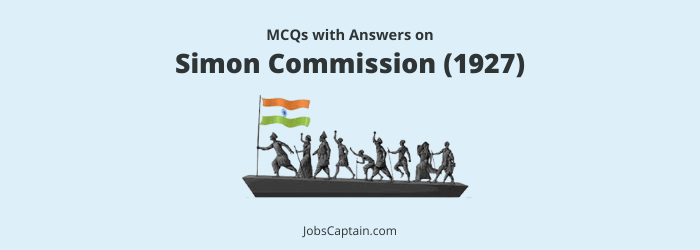
Question 1. Simon Commission in 1928 came to India with the purpose_______.
(A) To evaluate Military capacity
(B) To improve Agricultural sector
(C) To improve Education
(D) To consider Administrative reform
Question 2. Simon Commission of 1927 was boycotted because_______.
(A) There were differences among the members
(B) It supported the Muslim League
(C) There was no Indian member in the Commission
(D) Congress felt that the people of India are entitled to Swaraj
Question 3. When did Simon Commission visit India?
(A) 1931
(B) 1929
(C) 1928
(D) 1927
Question 4. Simon Commission was appointed in________.
(A) 1930
(B) 1928
(C) 1927
(D) 1925
Question 5. Who among the following members of Simon Commission belonged to liberal party?
(A) Viscount Burnham
(B) Stephen Walsh
(C) Major Attlee
(D) Sir John Simon
Question 6. On whose suggestions were the Indians kept out of the Simon Commission?
(A) Lord Irwin
(B) Sir John Simon
(C) Lord Chelmsford
(D) Lord Reading
Question 7. With reference to Simon Commission’s recommendations, which one of the following statements is correct?
(A) It recommended the creation of Indian Police Service with a provision for increased pay and allowances for British recruits as compared to Indian recruits
(B) It suggested the abolition of bicameral legislature at the centre
(C) It proposed the setting up of inter-provincial council under the Home Department
(D) It recommended the replacement of diarchy with responsible Government in the provinces
Question 8. Lala Lajpat Rai was injured________.
(A) In lathi charge in protest to Government of India Act
(B) In lathi charge in protest to Quit India Movement
(C) In lathi charge in protest to Rowlatt Act
(D) In lathi charge in protest to Simon Commission
Question 9. To whom was the title of ‘Punjab Kesari’ conferred?
(A) Lala Hardayal
(B) Lala Lajpat Rai
(C) Ranjeet Singh
(D) Bhagat Singh
Question 10. ‘Nehru Report’ was prepared by_______.
(A) B.L. Nehru
(B) R.K. Nehru
(C) J.L. Nehru
(D) M.L. Nehru
Question 11. Who among the following had demanded first the dominion status for India?
(A) Jawaharlal Nehru and Jagjeevanram
(B) Sir Tej Bahadur Sapru and Jaykar
(C) Pt. Motilal Nehru and Govind Ballabh Pant
(D) Rajagopalachari and Sardar Patel
Question 12. In which of the following sessions of Muslim League, M.A. Jinnah put forth his 14 point proposal?
(A) 1930
(B) 1929
(C) 1928
(D) 1927
Question 13. The radical wing of the Congress Party with Jawaharlal Nehru as one of its main leaders founded the independence for India. League in opposition to_________.
(A) The Montford reforms
(B) The Nehru Report
(C) The Home Rule Movement
(D) The Gandhi-Irwin Pact
Question 14. Who of the following was the President of ‘All Parties’ Conference held in February 1928?
(A) M.K. Gandhi
(B) Subhash Chandra Bose
(C) Dr. M.A. Ansari
(D) Motilal Nehru
Question 15. The Nehru Report was drafted by a Committee headed by ________ and the subject was ________.
(A) Jawaharlal Nehru; Constitutional arrangements in India
(B) Motilal Nehru; Constitutional arrangements in India
(C) Jawaharlal Nehru; Local SelfGovernment in India
(D) Motilal Nehru and Jawaharlal Nehru; India’s relationship with the British Empire
Question 16. Which of the following statements are true about the Simon Commission? Select the correct answer from the codes given below the statements.
- It was appointed to enquire into the working of the 1919 Act.
- It was headed by Sir John Simon.
- It recommended a Federal Form of Government.
- It was opposed by the Indian leaders.
(A) Only 1 and 2
(B) Only 2, 3 and 4
(C) Only 1, 2 and 3
(D) All of the above
Question 17. With reference to the period of Indian freedom struggle, which of the following was/were recommended by the ‘Nehru Report’?
- Complete Independence of India.
- Joint electorates for reservation of seats for minorities.
- Provision of fundamental rights for the people of India in the Constitution.
Select the correct answer using the codes given below.
(A) 1, 2 and 3
(B) 1 and 3
(C) 2 and 3
(D) Only 1
Question 18. Who amongst the following was responsible for the formation of the Independence of India League in 1928?
- Jawaharlal Nehru
- Subhash Chandra Bose
- Acharya Narendra Dev
- Jai Prakash Narayan
Choose your answer from the given code.
(A) 3 and 4
(B) 1 and 2
(C) 2, 3 and 4
(D) 1, 2 and 3
Question 19.
- Assertion (A): The Congress boycotted the Simon Commission.
- Reason (R): The Simon Commission did not have a single Indian member.
Select the correct answer by using the code given below.
(A) (A) is false, but (R) is true
(B) (A) is true, but (R) is false
(C) Both (A) and (R) are true, but (R) is not the correct explanation of (A)
(D) Both (A) and (R) are true and (R) is the correct explanation of (A)
Question 20.
- Assertion (A): Protest led by Lala Lajpat Rai, was organized in Lahore in 1928 against Simon Commission.
- Reason (R): Simon Commission did not have a single Indian member in it.
(A) (A) is false, but (R) is true
(B) (A) is true, but (R) is false
(C) Both (A) and (R) are true, but (R) is not the correct explanation of (A)
(D) Both (A) and (R) are true and (R) is the correct explanation of (A)
